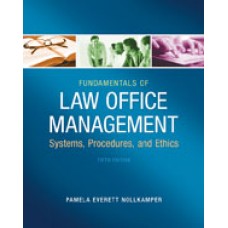This is completed downloadable of Solution Manual for Fundamentals of Law Office Management, 5th Edition

Product Details:
- ISBN-10 : 1133280846
- ISBN-13 : 978-1133280842
- Author: Pamela Everett Nollkamper
FUNDAMENTALS OF LAW OFFICE MANAGEMENT, Fifth Edition delivers the skills and knowledge you need to keep a law office running smoothly. In addition to an overview of the legal industry and the many roles paralegals play, the book takes an in-depth look at how legal environments differ from other businesses, including the ethical issues you may face. Discussions on law-specific office functions, such as managing the client funds account, timekeeping, docketing, and maintaining a law library help you understand the scope of a legal practice, while chapters on technology, client relations, and billing reveal the business side. Practical and skills-focused, FUNDAMENTALS OF LAW OFFICE MANAGEMENT, Fifth Editiont provides ample, in-text learning features, such as key words, ethics alerts, side bars, tech tips, and the latest Web references, along with supplemental, online tools for hands-on practice.
Table of Content:
- Ch 1: The Legal Marketplace
- Objectives
- Introduction
- Structure and Organization
- Private Law Firms
- Private Industry
- Government Agencies
- The Changing Marketplace
- Summary
- Chapter Illustration
- Chapter Review
- Examples for Discussion
- Assignments
- Self Test
- Key Words
- Internet Resources
- Ch 2: The Legal Team
- Objectives
- Introduction
- Historical Perspective
- Legal Team Members
- Summary
- Chapter Illustration
- Chapter Review
- Examples for Discussion
- Assignments
- Self Test
- Key Words
- Internet Resources
- Ch 3: Personnel Relations
- Objectives
- Introduction
- Management Objectives and Employee Relations
- Employee Objectives and Management Relations
- The Team Approach
- Conclusion
- Summary
- Chapter Illustration
- Chapter Review
- Examples for Discussion
- Assignments
- Self Test
- Key Words
- Internet Resources
- Ch 4: The Attorney-Client Relationship
- Objectives
- Introduction
- Variables Affecting Client Relations
- Cultivating Clients
- Media Advertising
- The Attorney-Client Relationship
- Attorney Discipline
- Conclusion
- Summary
- Chapter Illustration
- Chapter Review
- Examples for Discussion
- Assignments
- Self Test
- Key Words
- Internet Resources
- Ch 5: Paralegal Ethics and Client Relations
- Objectives
- Introduction
- History of Paralegal Ethics
- Paralegal Ethics and Client Relations
- The Unauthorized Practice of Law
- Conclusion
- Summary
- Chapter Illustration
- Chapter Review
- Examples for Discussion
- Assignments
- Self Test
- Key Words
- Internet Resources
- Ch 6: Legal Fees
- Objectives
- Introduction
- Historical Perspective
- Types of Fees
- Division of Fees
- Other Fees and Charges
- Statutory and Judicial Guidelines
- Fee Agreements
- Conclusion
- Summary
- Chapter Illustration
- Chapter Review
- Examples for Discussion
- Assignments
- Self Test
- Key Words
- Internet Resources
- Ch 7: Timekeeping
- Objectives
- Introduction
- Timekeeping Requirements
- Timekeeping Records and Reports
- Elements of Timekeeping
- Timekeeping Systems
- Timekeeping Ethics
- Common Timekeeping Problems
- Timekeeping Tips
- Conclusion
- Summary
- Chapter Illustration
- Chapter Review
- Examples for Discussion
- Assignments
- Self Test
- Key Words
- Internet Resources
- Ch 8: Billing and Financial Management
- Objectives
- Introduction
- The Art of Billing
- The Billing Process
- Billing Styles
- Collection
- Billing Ethics
- Financial Management
- Summary
- Chapter Illustration
- Chapter Review
- Examples for Discussion
- Assignments
- Self Test
- Key Words
- Internet Resources
- Ch 9: Managing the Client Funds Trust Account
- Objectives
- Introduction
- Types of Funds Held in the Trust Account
- Maintaining the Trust Account
- Interest on Lawyers’ Client Funds Trust Account
- Trust Account Abuses
- Conclusion
- Summary
- Chapter Illustration
- Chapter Review
- Examples for Discussion
- Assignments
- Self Test
- Key Words
- Internet Resources
- Ch 10: Technology in the Law Office
- Objectives
- Introduction
- Common Law Office Software
- The Internet
- Intranets and Extranets
- Electronic Mail
- Technology Ethics
- Conclusion
- Summary
- Chapter Illustration
- Chapter Review
- Examples for Discussion
- Assignments
- Self Test
- Key Words
- Internet Resources
- Ch 11: Law Office Systems
- Objectives
- Introduction
- Types of Systems
- Systems Development
- Systems Evolution
- Third-Party Systems
- Conclusion
- Summary
- Chapter Illustration
- Chapter Review
- Examples for Discussion
- Assignments
- Self Test
- Key Words
- Ch 12: Docket Control Systems
- Objectives
- Introduction
- Elements of a Docket Control System
- Calendaring Systems
- Tickler Systems
- Computerized Docketing Systems
- File Review System
- Conclusion
- Summary
- Chapter Illustration
- Chapter Review
- Examples for Discussion
- Assignments
- Self Test
- Key Words
- Internet Resources
- Ch 13: File and Records Management
- Objectives
- Introduction
- Filing Systems
- File Opening
- File Maintenance
- File Closing, Retention, and Destruction
- File and Records Management Ethics
- Conclusion
- Summary
- Chapter Illustration
- Chapter Review
- Examples for Discussion
- Assignments
- Self Test
- Key Words
- Internet Resources
- Ch 14: Law Library Organization and Management
- Objectives
- Introduction
- The Nature of Law
- Classes and Authority of Law
- Law Library Organization and Procedures
- Law Library Technology
- Court Forms, Form Files, and Knowledge Banks
- The Law Librarian
- Conclusion
- Summary
- Chapter Illustration
- Chapter Review
- Examples for Discussion
- Assignments
- Self Test
- Key Words
- Internet Resources
- Appendix A: Answers to Self-Test Questions
- Appendix B: Associations for Paralegals, Legal Secretaries, and Managers
- Appendix C: Definitions and Code of Ethics of National Paralegal Associations
- Glossary
- Bibliography
- Index





